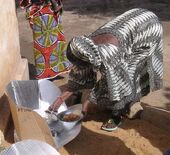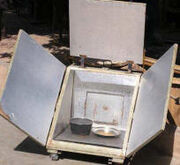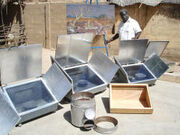(→Climate, Culture, and Special Considerations: Juan Urrutia Sanz comments) |
Paul Hedrick (talk | contribs) |
||
| Line 1: | Line 1: | ||
{{GoogleTranslateLinks}}<br> |
{{GoogleTranslateLinks}}<br> |
||
| + | ==Events== |
||
| + | See [[Calendar of events]] |
||
==News and Recent Developments== |
==News and Recent Developments== |
||
[[File:Deborah_Dao_2009_Mali.jpg|thumb|170px|Deborah Dao as she cooks a meal for her family]] |
[[File:Deborah_Dao_2009_Mali.jpg|thumb|170px|Deborah Dao as she cooks a meal for her family]] |
||
Revision as of 17:46, 23 May 2010
Events
News and Recent Developments

Deborah Dao as she cooks a meal for her family
- December 2009: Emancipated from the Smoky Kitchen by the Power of the Sun. Deborah Dao cooks her family three square meals a day - a responsibility which in this economy requires nearly constant preparation and cooking. Most women spend all day pounding millet, mixing the batter, chopping firewod and fanning the flames to cook their family's toh, but here there is no burning hearth, no fire, no smoke. On a closer look, you can see that Deborah is cooking with a solar oven - a wonderful appliance made by local carpenters with their own wood and just a few imported materials which harnesses solar radiation to collect heat energy.
- December 2009: Mali: Solar cooking revolutionizes womens' lives in the kitchen - Deutsche Welle

Mariam Toure proudly serves samples of her solar meal.
- March 2008: The Association of Handicapped Women of Mali (AMAFH) continues to arrange solar cooker training for its members in Bamako, with organizational support from the Association of Women Engineers (AFIMA) and financial assistance from Dutch KoZon Foundation. In 2006, AMAFH taught 60 deaf and hard-of-hearing women how to use a CooKit solar cooker during a 2-day training. In a follow-up visit months later, at a school for deaf children, the women cooked a delicious solar feast. Fifty women with leprosy were trained in early 2007. With the loss of nerve sensation caused by the disease, traditional open fire cooking can be dangerous for these women because they can unknowingly get burned. Another benefit is that the women have increased status in the community because they now know something that most don’t: how to cook food with the sun. They said that with the CooKit they can prepare special recipes for their husbands, prepare groundnuts for their children, and even sell solar-cooked meat in the market. One remarkable woman, Mariam Toure, has lost all but one finger. Yet, she already has plans to lead a training early this year for another group of women with the disease. AMAFH also led a 2-day solar cooking workshop for 20 mentally disabled women in late 2007, which was well received. Source: Wietske Jongbloed
- March 2008: Longtime solar cooker builder and promoter Gnibouwa Diassana reports that 40 solar box cookers have been assembled and distributed to villagers in Nioro du Sahel, near the border with Mauritania. Nioro du Sahel suffers from an acute shortage of firewood for cooking. Diassana says that a special cooking vessel has been made to accommodate the local staple of couscous with millet or corn.
- September 2007: Zeneb Guisse, a handicapped woman, reports that most people in Mali know about the solar CooKit. Since 2001 the the Foundation has financed more than 14 Cookit trainings. Handicap International has conducted one training and the UN Environment Program has also conducted one. A team from the national television is invited at every training (always on the budget and rather expensive) and broadcasts it then mostly the same evening with the news. This does not mean that it is being used by all the women who saw the broadcasts. Fifteen dollar for a CooKit and a pot is for a lot of women too expensive. Another big problem in Mali is the large families of 12 to 20 persons for whom the meals have to be cooked. Their pots are far too big to be used in the CooKit. It was first tried to solve the problem by using two CooKits. But that was not a solution, except for bachelors. With large hay baskets and hay bags (thanks to the model of David and Ruth Whitfield), in which the big pots can be put, integrated cooking is now being introduced.
- April 2007: Gnibouwa Diassana of W.V.I. International reports on a project designed to improve the lives of women in the village of Nara in the west of Mali, not far from Mauritania. His organization brought 40 cookers to this area is in the deep Sahel with acute shortage of firewood. They report designing a special cooking vessel for couscous made with millet or corn, which is the local staple.

A wooden solar box cooker based on a model by Gnibouwa Diassana
- November 2006: J.P. Martin-Vallas of Montpellier, France recently traveled with his partner to Mali. They took two solar cookers — a box-type cooker based on a design by Gnibouwa Diassana of Bla, Mali and an SK-14 parabolic-type cooker. The pair visited several experienced solar cooker promoters: Diassana; Bernard Ledea Ouedraogo of Burkina Faso, who assembles SK-14s; and Maï Kamate, who works with carpenters to make solar box cookers based on a Bolivia Inti design. They also met with solar cooks and led a few solar cooking demonstrations at hotels and markets they patronized. Martin-Vallas saw several locally made and imported solar cookers, but many were in poor condition or seldom used. During the trip, Martin-Vallas inquired how much people spent on firewood. Prices from one city to another varied greatly depending on scarcity. Free firewood collection is still possible in some rural villages, particularly in the north. Contact: J.P. Martin-Vallas
- Summer 2006: Solar Household Energy's first bulk delivery of HotPots arrived this summer in Mali, West Africa. The container of 1,000 cookers was purchased by a Malian energy services company which has promoted solar cooking in Mali for a number of years and will be a regional distributor of HotPots. To learn more about our West Africa programs, go here.

Gnibouwa Diassana with several of his solar box cookers
- August 2006: Gnibouwa Diassana of Bla won a "2006 Ashden Award for Sustainable Energy" worth 2,500 pounds sterling. The funds will enable his project Sun for All to increase production of cookers and to reach out to more women's groups and other community organizations. Diassana has built a variety of solar cookers, plus a solar food dryer and solar water heater. Most of the 95 solar cookers he has built are of the box type with three reflectors, based on a design by the Swiss organization Group ULOG. He has found homes for most of the cookers with organizations of artisans, nonprofits, women's groups and individual families. He reports that the cookers have been adapted for Mali and can be constructed with locally available materials and tools, even in remote areas. To facilitate getting cookers into the hands of people who need them, Diassana has sold cookers at half price or on credit. He has been able to follow up directly with most of the users and observes that they are using less conventional fuel. He estimates that about 950 people have directly benefited from his cookers, while 10,000 more have witnessed solar cooking at his exhibitions and demonstrations. Radio and television coverage has spread the word further. Diassana reports that the effects of deforestation have become increasingly visible near Bla in the past few years, and that his work with solar cooking is meant to address this problem while also helping women save money and time and reduce their exposure to smoke. His project has received some outside support, but his personal donations have sometimes exceeded 40% of the project's budget. He credits Roger Bernard of France and Angela Calvo of Italy as his main solar cooking influences. With his new funds from England to promote Swiss-designed cookers, Diassana illustrates the international connectivity in solar cooking.
The History of Solar Cooking in Mali
The Sahelian nation of Mali is the site of several solar cooking projects. Desertification is of course an immense problem in this part of Africa. Only 10% of the land has any forest cover, and deforestation continues to occur. As in other areas, clearing land for agriculture and grazing is assumed to be the principal reason for the forests' decline, but there is also recognition that over 70% of wood production is used for cooking. Solar cooking offers one way to stem this unwanted development in Mali.
Researchers at the University of Torino, studying the problem, have experimented with a wide range of fuel-saving devices, dryers, water heaters, solar lighting panels, and solar cookers. (As one researcher said-, "Every day when I get up (and look at the sun), I see all that energy going to waste.) Considerable study done under the auspices of the University, with joint efforts of the Faculty of Agricultural Science and the Interdepartmental Centre of Women's Studies, has included surveys, interviews, and field analyses of both problems and some suggested solutions. Local associations promote various fuel saving devices, such as metal stoves or parabolic cookers; other promote solar cooking (see below for an example). But in a nation without adequate communication channels (television or daily newspapers) and a population with only a 35% literacy rate, spreading new technology is difficult. Radio broadcasting is thought to be the most promising dissemination media. Most important in this situation is the awareness of the problem and the willingness to seek solutions.
One single person, Gnibouwa Diassana, long committed to solar cooking, has managed in these circumstances to make and sell around 50 cookers of the wooden box type. He does this on his own, without assistance even from the NGO for which he works on other kinds of projects. This sole person, working only with a son, has a promotion plan for an energy week and even a business plan that would permit expanded production of solar box cookers. He hopes to find partners among women's organizations but knows that resistance to change, and rigid gender based roles, make it difficult for women to pursue the purchase of cookers. He is however a determined man and perseveres in his work. (Pictures and story, Solar Cooker Review, March 2003).
Another project created by an individual is the work of Lanseri Niare, who has been introducing box cookers, both by teaching people how to build their own cooker and how to use the box when built. Major problems encountered in this project have been glass breakage, termites if the box is used on the ground, and the Harmattan period (a severe windy season) which brings much dust, so that even when sunny, cooking is difficult) (Solar Cooker Review, Dec. 98).
One other project, which has proven successful in Mali, operates under the auspices of the KoZon Foundation, a Dutch organization that works through the western African Sahelian nations. From a beginning in Burkina Faso (see above), the efforts of KoZon and its dedicated volunteer Wietske Jongbloed, have introduced CooKits in Mali since 2001. Wietzke operates at a very grassroots level, taking cookers (mostly using CooKits made in the Sahel to keep cost low) to marketplaces for demonstrations. The CooKits themselves were initially imported from abroad, and then purchased from Burkina Faso. This operation, relatively new, has not yet been evaluated by KoZon, but is gradually moving forward, in cooperation with the Association des Femmes Ingénieurs du Mali.
[Information for this section was taken originally from State of the Art of Solar Cooking by Dr. Barbara Knudson]
Climate, Culture, and Special Considerations
Based on knowledge gained from visiting solar cooking promoters and appropriate technology organizations, J.P. Martin-Vallas has developed some recommendations for solar cooker dissemination in Mali:
- Target cities where firewood is quite expensive, such as in Kayes, Niafunke, and Tombouctou;
- Encourage dissemination by women;
- Focus on durable box-type solar cookers that accommodate large cooking pots;
- Engage local carpenters to make the cookers; and
- Provide a five-year guarantee for each cooker sold.
J.P. Martin-Vallas concluded that imported parabolic-type solar cookers are currently too expensive for most Malians. One way to lower prices, he says, would be to import bulk aluminum sheets and cut panels on site.
The following chart shows some sample annual firewood expenditures for households of 10 people. (Note: 500 CFAs is approximately US $1.)
|
City |
Annual Firewood Expenditure |
|
Kayes |
300,000 |
|
Niafunke |
300,000 |
|
Tombouctou |
280,000 |
|
Douentza |
180,000 |
|
Segou |
150,000 |
|
Waki/Niafunke |
150,000 |
|
Bourem |
120,000 |
|
Koutiala |
100,000 |
|
Koulikoro |
75,000 |
|
Mopti |
75,000 |
|
Kerouane |
60,000 |
Northern part of the country: Desert (Sahel). Southern part of the country: Sunny, little firewood, and populated. (Source: Juan Urrutia Sanz, 2010-Feb-25)
See also
- Discussion of northern Africa's suitability for solar cooking
- Solar cooker dissemination and cultural variables
Resources
Possible funders for solar cooking projects in Mali
Blogs
- hannah-in-mali-2008-2010.blogspot.com
Reports
- February 2009: Rapport d’activité sur la cuisine solaire au Mali-2008-2009
- February 2008: Rapport d’activité sur la cuisine solaire au Mali-2007-2008
- February 2007: Rapport d’activité sur la cuisine solaire au Mali-2006-2007
- February 2006: Rapport d’activité sur la cuisine solaire au Mali-2005-2006
- July 2006: Use of the CooKit by Handicapped Women in Mali - Wietske Jongbloed
- March 2006: Rapport d’activité sur la cuisine solaire au Mali-2005-2006
Articles in the media
- March 2009: Promotion des énergies renouvelables : L'énergie solaire ou le pétrole sous-valorisé du Mali - L'indépendent
Web pages
Contacts
The entities listed below are either based in Mali, or have established solar cooking projects there:
SCI Associates
- Main article: Solar Cookers International Association
NGOs
Manufacturers and vendors
Individuals
Government agencies
Educational institutions
See also
References


